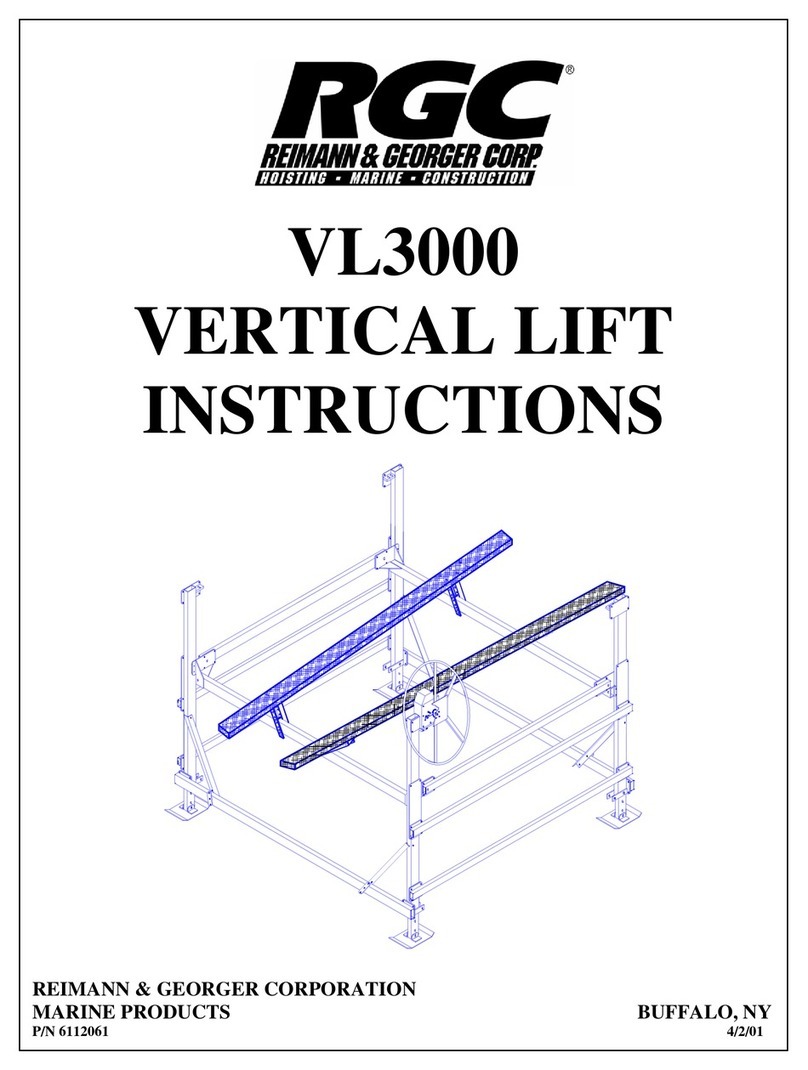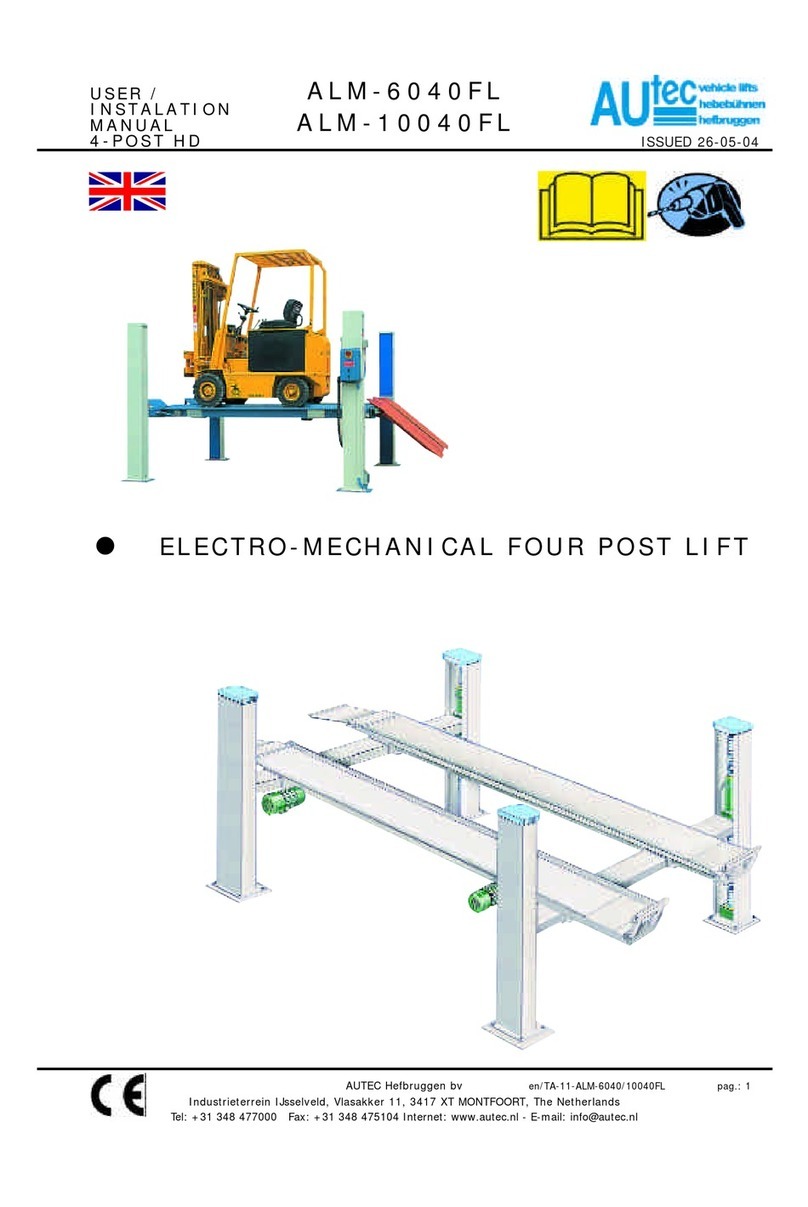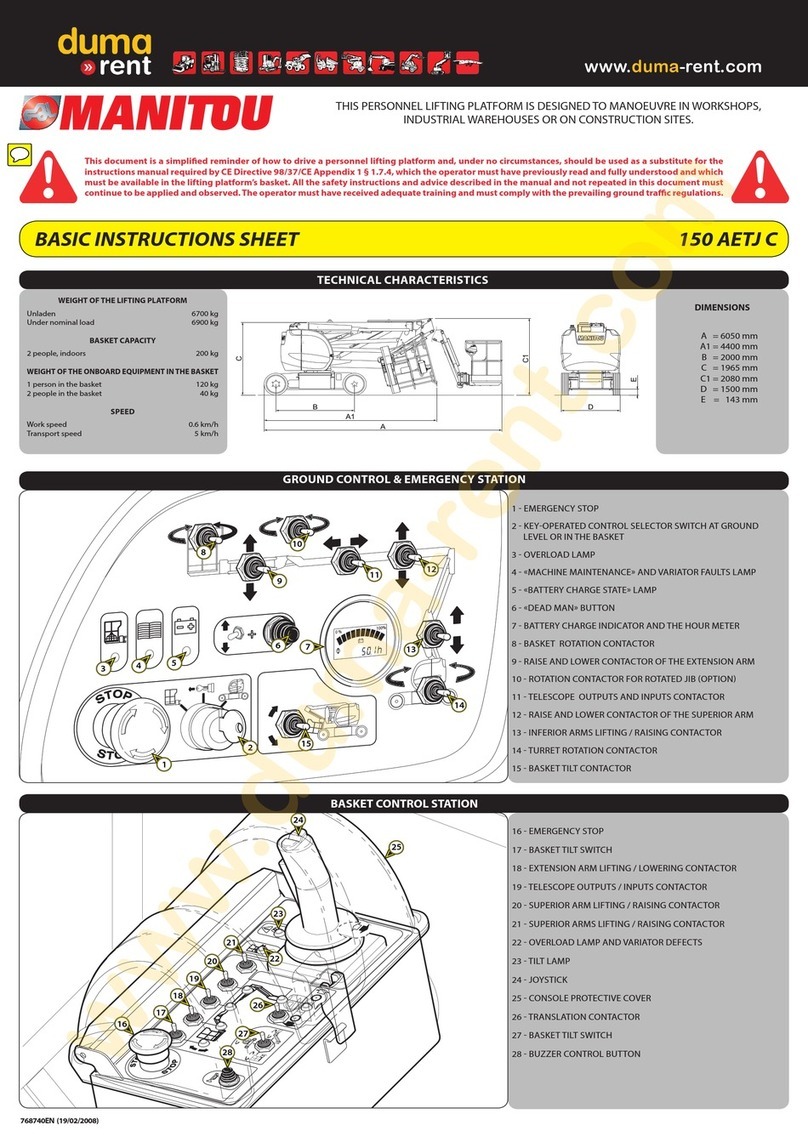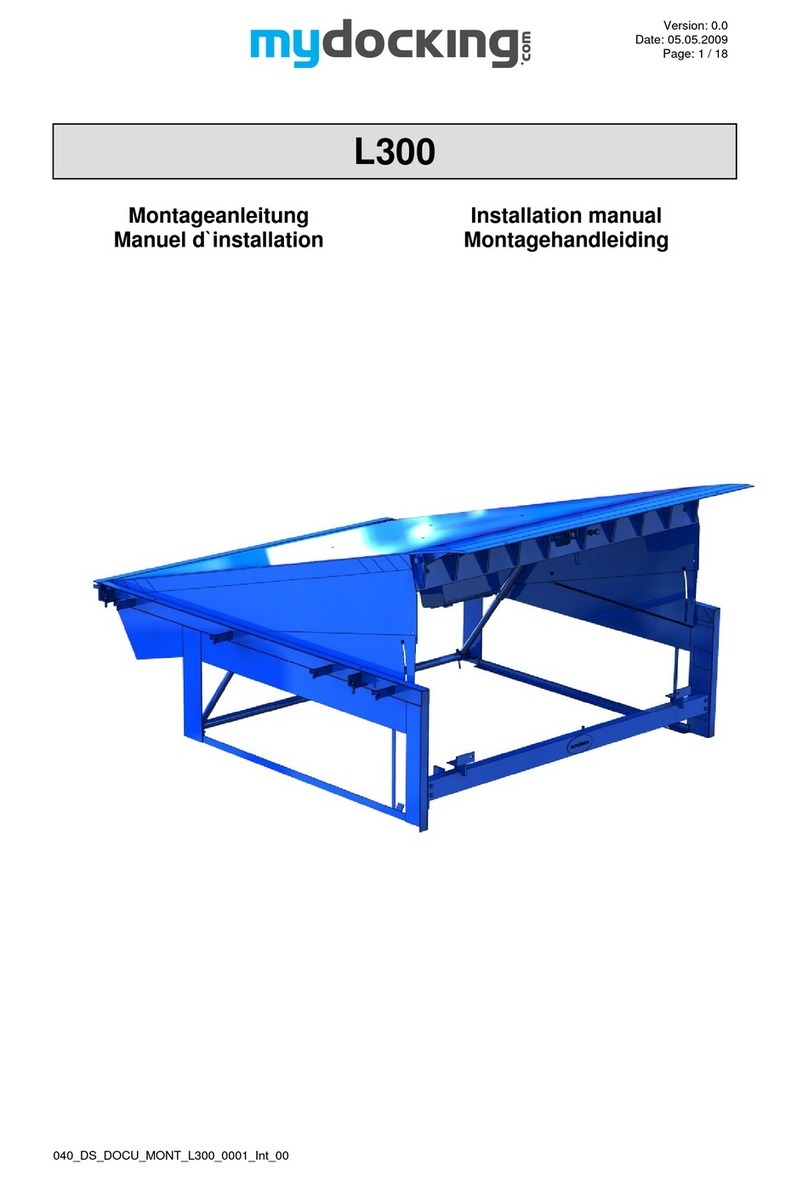stertil-KONI ST 1082-F/BAT Setup guide

Mobile Column Lifts
ST 1082-F/BAT
ST 1082-R/BAT
Installation - operation – service
32738980-A


PLEASE DELIVER TO THE LIFT ALL OPERATION, INSPECTION AND MAINTENANCE MANUALS AND ALL
OTHER INSTRUCTIONAL MATERIAL FURNISHED WITH THE LIFT, TO THE LIFT OWNER/USER/EMPLOYER.
PLEASE READ AND UNDERSTAND ALL INSTRUCTIONS IN THIS MANUAL
BEFORE INSTALLING, OPERATING OR MAINTAINING THIS LIFT
DIRECTIONS ASSEMBLY AND SERVICING MANUAL
FOR THE 18,000 LBS STERTIL-KONI HYDRAULIC MOBILE COLUMN LIFTS
MODEL
ST 1082-F/BAT ST 1082-R/BAT
Starting at Serial Number
TM 139067
This document belongs with mobile column lift no.:
TM...................
Date first used:
……………….
Date:12-04-2007

ST 1082-F/R
EC DECLARATION OF CONFORMITY in application of the European 'Machines' Directive (98/37/EC)
ALI DECLARATION OF CONFORMITY in application of the ANSI\ALI ALCTV-1998 and UL201
Manufacturer : Stertil B.V., Postbox 23, 9288 ZG
KOOTSTERTILLE Holland
Machine : Hydraulic mobile column lifts
Make : STERTIL-KONI
Model : ST 1082-F/BAT Fixed wheels and fixed forks
: ST 1082-R/BAT Retractable wheels and fixed
forks
: ST 1082-F/V/BAT Widened model with fixed
wheels and fixed forks
Version : Battery powered
Options : Adjustable forks
: Wheel adaptors
: Longer extensions and wheel adaptors
The undersigned U.Bijlsma, Director, for this purpose authorized by Stertil BV, hereby declares that the mobile column lift described
above, has been designed according to the 'Machines' Directive, ANSI\ALI ALCTV-1998 and UL201 and has been found to meet the
fundamental safety requirements stipulated by these directives.
This Wheel Engaging Mobile Automotive Lifts are approved by: Stertil, Kootstertille
INTERTEK TESTING SERVICES NA. Inc. U.Bijlsma
3933 US Route 11. Cortland, NY 13045 Director
Telephone: 607-753-6711 Fax: 607-756-9891 Signature:
WEB: www.intertek-etlsemko.com Date: 01-05-05
Under report no J99024825-003

1
Contents Page
PREFACE.............................................................................................................................................................................3
1.
GENERAL.................................................................................................................................................................5
1.1
MANUFACTURER'S INFORMATION..................................................................................................................... 5
1.2
SPECIFICATIONS ....................................................................................................................................................... 5
2.
DIRECTIONS ...........................................................................................................................................................6
2.1
SCOPE............................................................................................................................................................................ 6
2.2
GUARANTEE AND LIABILITY ................................................................................................................................ 6
2.4
SAFETY MEASURES .................................................................................................................................................. 7
3.
DESCRIPTION OF THE LIFTING SYSYEM....................................................................................................11
3.1
STRUCTURE OF THE COLUMN LIFT .................................................................................................................12
4.
INSTALLATION....................................................................................................................................................13
4.1
UNPACKING AND HANDLING THE LIFTING COLUMN ................................................................................ 13
5.
GENERAL USE......................................................................................................................................................14
5.1
CONTROL................................................................................................................................................................... 14
5.2
CONNECTING LIFTING COLUMNS..................................................................................................................... 14
5.3
DESCRIPTION OF THE MOBILE COLUMN LIFT SYSTEM............................................................................14
5.4
WHEEL ADAPTERS (OPTIONAL)......................................................................................................................... 16
5.5
LONGER WHEELADAPTORS (OPTIONAL ONLY ON ST 1082-F) .................................................................16
5.6
ADJUSTABLE FORKS (OPTION)........................................................................................................................... 17
5.7
OPERATING THE PALLET LIFTING MECHANISM......................................................................................... 18
5.8
USING OUTDOORS................................................................................................................................................... 18
5.9
VEHICLE TECHNOLOGY....................................................................................................................................... 19
6.
OPERATION ..........................................................................................................................................................20
6.1
PREPARATION.......................................................................................................................................................... 20
6.2
RAISING AND LOWERING ALL LIFTING COLUMNS..................................................................................... 20
6.3
RAISING AND LOWERING OF TWO LIFTING COLUMNS............................................................................. 20
6.4
RAISING AND LOWERING A SINGLE LIFTING COLUMN............................................................................. 20
6.5
EMERGENCY RELEASE ......................................................................................................................................... 21
7.
INSPECTION AND MAINTENANCE.................................................................................................................21
7.1
GENERAL ................................................................................................................................................................... 21
7.2
DAILY (BY OPERATOR).......................................................................................................................................... 21
7.3
MONTHLY (BY OPERATOR) ................................................................................................................................. 22
7.4
ANNUALLY (BY SERVICE DEPARTMENT)........................................................................................................ 23
7.5
MAINTENANCE SWITCHES................................................................................................................................... 24
7.6
REMOVAL/INSTALLATION OF THE LIFTING CYLINDER ........................................................................... 24
7.7
ADJUSTING THE PALLET JACK MECHANISM............................................................................................... 25
7.8
ADJUSTING RETRACTABLE FRONT WHEELS ............................................................................................... 25
8.
SERVICE.................................................................................................................................................................26
8.1
GENERAL ................................................................................................................................................................... 26
8.2
TROUBLE-SHOOTING............................................................................................................................................. 28
8.3
IDENTIFICATION ..................................................................................................................................................... 31
9.
LIST OF PARTS AND APPENDICES.................................................................................................................31
9.1
PARTS LIST................................................................................................................................................................ 31
9.2
ORDERING SPARE PARTS ..................................................................................................................................... 31
FIG. A - MOBILE LIFTING COLUMN ........................................................................................................................... 32
FIG. B - MOBILE LIFTING COLUMN ........................................................................................................................... 34
FIG. C – HYDRAULIC UNIT ............................................................................................................................................ 36
FIG. D – HYDRAULIC CYLINDER................................................................................................................................. 37
FIG. E - CONTROL BOX
.................................................................................................................................................. 38
FIG. F – SCHEMATIC DIAGRAM................................................................................................................................... 40

2
FIG. G - CONNECTION CABLE...................................................................................................................................... 41
FIG. H - PALLETJACK SERVICE KITS ........................................................................................................................ 42
FIG. I - LABEL LOCATIONS ........................................................................................................................................... 43
FIG. J - WHEEL ADAPTORS & EXTENDED ARM (OPTION) ................................................................................. 44
FIG. K - DIMENSIONAL DRAWING .............................................................................................................................. 45
INSPECTION CHECK LIST............................................................................................................................................46

3
PREFACE
Prior to the operation of your Stertil-Koni mobile lift make sure that you read the instructions thoroughly. These instructions
are found in this manual. Please note that your warranty can be voided if you do not read the manual and understand its
content
If you have any questions, concerning operation, safety or application of your mobile lift, please contact Stertil Koni USA at
the following toll-free number: 800 336 6637 or call 410 643 9001. The address for Stertil Koni USA Inc. is 200 Log
Canoe Circle, Stevensville, Maryland 21666.
An automotive lift operator shall have certain qualifications before he/she can safely operate a Stertil Koni mobile lift and
these include ability in written or oral communications as demonstrated by either a high school diploma or certificate of
equivalency, aptitude test or job experience. He/she must also have the ability to understand the mathematical, mechanical
and electrical principles of automotive lifts as demonstrated by one of, or a combination of aptitude test, training program,
technical vocational school or job experience.
The owner/employer of the Stertil Koni mobile lift must ensure that the operator of the mobile lift must be instructed and
trained in the safe use and operation of the lift using the manufacturer-provided instructions and warning labels and the
Automotive Lift Institute Publications, "Lifting It Right" and "Safety Tips".
The lift that has been delivered to you contains the operating instructions, general safety information, safety tips and
warning labels on the master control console. As an owner, or employer, it is requested that you display these materials in a
conspicuous location in the lift operating area.
The owner or employer shall appropriately document operator training by completing an operator training log which shall
be part of the management documentation.
The operator shall operate the automotive lift only after being properly instructed or trained in accordance with
manufacturer supplied instructions found in this manual.
The operator shall use all applicable safety features provided on the automotive lift and operate the lift in accordance with
the instructions provided by Stertil-Koni.
The lift operator or employer shall take all appropriate steps to follow the recommended inspection procedures of the lift
manufacturer but in no event shall the lift operator fail to inspect or take notice of the following features on a daily basis.
1. accessibility and readability of the operating procedures, safety tips and generic safety material
2. accessibility and readability of safety warning labels
3. readability of the rated load capacity of the lift
4. proper operation of the lift controls, restraints and locking devices
5. deformation or excessive wear of any of the lift structural components
6. deformation or excessive wear of other components such as hoses, electrical wires
7. evidence of hydraulic leaks
8. unusual noises
If any of the conditions described above are observed before, during or after operation of the lift, the operator shall stop
using the lift and report the condition to the supervisor, employer or owner. If any of the conditions listed above are
observed, then the lift shall not be used until the cause of the problem has been determined and the appropriate repairs made
by qualified Stertil Koni service authorized personnel. In order to ensure that the lift is not used until the repairs have been
effected, the lift shall be locked out or tagged in accordance with ANSI/Z244.1-1982.
The owner or employer shall establish a periodic preventive maintenance procedure in accordance with the
recommendations listed in this manual.
Stertil-Koni USA shall not be responsible for any actions not specifically called out for in this manual or in this notice.
Please note that there shall be no modifications or reconstruction made to the Stertil Koni mobile lift without the express
written permission of the manufacturer.
Please make sure that caution labels are not frayed and are on the lift. Please call the manufacturer if these caution labels
have been removed or through age are no longer on the lift.

4
Please read and understand the attached Statement of Warranty for the Stertil Koni mobile lift.
Thank you for the purchase of your Stertil Koni product.
Please contact Stertil-KONI USA for the location of authorized Service Centers throughout the United States.
Stertil-Koni USA Inc.
200 Log Canoe Circle
Stevensville, Maryland 21666
tel. 00 1 410 643 9001
fax. 00 1 410 643 8901
Toll-free number: 800 336 6637
Column Serial Numbers: _______________________ _______________________
_______________________ _______________________
_______________________ _______________________
_______________________ _______________________
___________________________________________________________________________________________
Signature Date

5
1. GENERAL
1.1 MANUFACTURER'S INFORMATION
Stertil BV Kootstertille (NL)
Westkern 3, 9288 CA Telephone 31(0)512334444
Postbus 23, 9288 ZG Telefax 31(0)512334430
Website: www.stertil.nl
1.2 SPECIFICATIONS
Also see type plate on the mobile column lift.
Model ST 1082-F/BAT ST 1082-R/BAT
Capacity 18,000 lbs
Pressure relief valve 3,800 psi (sealed ex-works with plastic cap)
Electrical power
24vdc
4HP
Mains supply (bat. charger)
1x115V 60 Hz 2A 1x phase, 1x zero, 1x earth
Main battery fuse 200 AT
Operational voltage 24 V=
Stroke 69”
Lifting speed 44"/min
Lifting/lowering time 94 sec/68 sec
Noise level max 73 dB(A)
Set-up Indoors / outdoors
Weight 1250 lbs
Lifting column interconnection
cable length 39' - 4"
Maximum distance between
lifting columns 29' - 6"
Maximum floor suface
pressure 900 psi (per front support) – ST 1082-R/BAT
7000 psi (per wheel) – ST 1082-F/BAT
Maximum floor load
7000 lbs (per front support)
Operation temperature 5 to 122° F (-15 to +50°C)

6
2. DIRECTIONS
2.1 SCOPE
This manual refers to the Mobile Column Lift.
This manual contains useful and important information for proper functioning and maintenance of the lifting system. It
also contains important instructions to prevent accidents and serious damage prior to and during operation of the lifting
system, and it enables the product to perform as safelyand flawlesslyaspossible.Readthismanualcarefullybeforeusing
the lifting system, familiarize yourself thoroughly with the functioning and operation of the lifting system and strictly
observe the directions given.
2.2 GUARANTEE AND LIABILITY
See the terms of delivery and order conformation.

7
2.4 SAFETY MEASURES
The lifting system is provided with safety and protection features. Even so, caution is required when using the lifting
system.
Work safely!
Stertil B.V. has made effort to inform you about possible dangers associated with operation of the lifting system.
You must ensure and are responsible for compliance with these behavioral guidelines.
The buyer/user is obliged to familiarize operating, cleaning and maintenance personnel with these instructions.
Upon their arrival, check deliveries for:
- any damage and/or missing parts due to transport. Make sure that the carrier draws up a transport damage report
on the spot.
- correctness and completeness; have all parts (additionally) and or accessories ordered been supplied?
In the event of damage always contact Stertil B.V. or the supplier.
All worn or broken parts need to be replaced with genuine lift manufacturer supplied parts.
MANUFACTURERS INSTRUCTIONS TO THE LIFT OWNER/EMPLOYER
The owner/employer shall ensure that lift operators are qualified and that they are trained in the safe use and
operation of the lift using the manufacturers operating instructions; ALI/SM 93-1, ALI Lifting it Right safety
manual; ALI/ST-90, ALI Safety Tips card; ANSI/ALI ALOIM-2000, American National Standard for
Automotive Lifts-Safety Requirements for Operation Inspection and Maintenance; ALI/WL Series, ALI
Uniform Warning Label Decals/Placards.
The owner/employer shall establish procedures to periodically inspect the lift in accordance with the lift
manufacturers instructions; ANSI/ALI ALOIM-2000, American National Standard for Automotive Lifts-Safety
Requirements for Inspection and Maintenance; and the employer shall ensure that lift inspectors are qualified and
that they are adequately trained in the inspection of the lift.
The owner/employer shall maintain the periodic inspection and maintenance records recommended by the
manufacturer or ANSI/ALI ALOIM-2000, American National Standard for Automotive Lifts-Safety
Requirements for Inspection and Maintenance; and the employer shall ensure that lift inspectors are qualified and
that they are adequately trained in the inspection of the lift.
The owner/employer shall display the lift manufacturers operating instructions; ALI/SM-01, ALI Lifting it Right
safety manual; ALI/ST-90, ALI Safety Tips card; ANSI/ALI ALOIM-2000, American National Standard for
Automotive Lifts-Safety Requirements for Operation Inspection and Maintenance, Vehicle Lift Points for
Service Garage Lifting; ANSI/SAE J2184-may00 in a conspicuous location in the lift area convenient to the
operator.
The owner/employer shall provide necessary lockout/tagout means for energy sources per ANSI Z244.1-1993,
Safety Requirements for the Lockout/Tagout of Energy Sources, before beginning any lift repairs.
The owner/employer shall not modify the lift in any manner without the prior written consent of the manufacturer.

8
IMPORTANT SAFETY INSTRUCTIONS
-Read all instructions.
-If an extension cord is necessary, a cord with a current rating
equal to or more than the equipment must be used. Cords
rated for less current than the equipment may overheat.
Care should be taken to arrange the cord so that it will not
be tripped over or pulled.
-Always unplug equipment from electrical outlet when not in
use. Never use the cord to pull the plug from the outlet.
Grasp plug and pull to disconnect.
-Let equipment cool completely beforeputtingaway. Loopthe
cord loosely around equipment when storing.
-To reduce the risk of fire, do not operate equipment in the
vicinity of open containers of flammable liquids (gasoline).
-Adequate ventilation should be provided when working on
internal combustion engines.
-Keep hair, loose clothing, fingers and all parts of the body
away from moving parts.
-To reduce the risk of electrical shock, do not use on wet
surfaces or expose to rain.
-Use only as described in this manual. Use onlymanufacturers
recommended attachments.
-ALWAYS WEAR SAFETY GLASSES. Everyday eyeglass
only have impact resistant lenses, they are not safety glasses.
-Use by untrained people could result in serious injury and/or
damage.
-Do not use the lifting system outdoors if the wind velocities
mentioned in paragraph 5.5 are exceeded
-If the lifting system is used outdoors do not leave the vehicles
unattendedintheliftedposition.The windspeedmaychange
and exceed the safety limits.
-Danger of getting injured by electrical shock.
-Only remove thecoverstocarryoutmaintenance,ensurethat
the lifting system is disconnected from the power supply.

9
-Care must be taken as burns can occur from touching hot
parts.
-Prevent damage to the power feed cables on account of
driving over or heavy or falling objects.
-Do not drive over interconnecting cables. Always disconnect
interconnecting cables and remove from
vehicle travel path before moving vehicle.
-Do not operate equipment with a damaged cord or if the
equipment has been dropped or damaged until it has been
examined by a qualified serviceman.
-In case of using one or two lifting columns (in paired
operation), be sure that this will not result in stability risks.
In case of doubt, consult your superior. Unsafe lifting can
result in serious injury and damage to the lifting system
and/or vehicles.
-This lifting system should only be used for lifting of vehicles
and not for other applications. The positioning of the lifting
system must be done in a way that a safe working area will
be obtained above and around the lifting columns, thereby
creating escape paths for emergency situations (leave
passageways of at least 24").
-For important vehicle technology see 5.7.
-If a vehicle is in the lifted position, its air suspension system
may not be used in a view of possible change of track width
and/or wheel base.
-Use the lifting columns only on a hard and level floor with
sufficient bearing capacity, see 1.2 Specifications for floor
pressure and floor load.
- Once desired height has been reached, it is recommended
but not required that the lift be lowered into the mechanical
locks.
SAVE THESE INSTRUCTIONS

10

11
3. DESCRIPTION OF THE LIFTING SYSYEM
For the hydraulic system diagram see figure L.
The mobile column lift is a movable electrically driven hydraulic
column lift used for lifting heavy vehicles. At least two lifting
columns are required for lifting a vehicle. The number of lifting
columns required depends on the weight of the vehicle and the
number of axles.
The main components of the mobile column lift are shown below:
Usually, a set of four lifting columns is used
Each lifting column has a lifting capacity of 18,000 lbs. Consequently, four columns have a total lifting capacity of
72,000 lbs. The total lifting capacity can be increased by adding more lifting columns.
The columns are interconnected so as to form a ring circuit. All the control signals are through the
connecting cables. Each column has a mains connection for the integrated battery charger.
The control system on the lifting columns ensures that the columns are raised or lowered synchronically.
Each lifting column is equipped with a position sensor which transmits the height positions to the control system.
The control system controls and protects the lifting system during lifting or lowering as follows:
- At a difference in height between the lifting columns of over 5/8" and less than 1 1/4"mm, an
extra adjustment valve in the hydraulic system opens and remains open until the difference has been cancelled out.
Fig. 3
1. Column
2. Potentiometer
3. Mechanical lock
4. Hydraulic unit
5. Control box
6. Electrical connector
7. Main switch
8. Automatic battery charger
9. Fuseholder 200A
10. Batteries
11. Pallet jack
12. Guide block
13. Lifting fork
14. Wheel adaptor (option)
15. Cylinder
16. Fixed wheels (model ST 1082-BAT/F)
17. Adjustable forks (option)
18. Retractable wheels (model ST 1082-R/BAT

12
- At a difference in height of over 1 1/4" and less than 2 3/8", lowering is interrupted. A lifting
fork may be blocked; the cause of the failure must then be traced first. Lifting is still possible, the adjustment valve
in the hydraulic system will open and remain open until the difference has been cancelled out.
- At a difference in height of over 2 3/8" mm, the control voltage is switched off, thus blocking all
movements. The cause of the failure can then be traced.
In addition, the control system has been designed so that:
- Each lifting column can be operated separately
- Any pair of axles can be handled separately
Also see section 6, Operation
3.1 STRUCTURE OF THE COLUMN LIFT
Each lifting column consists of (see figure 3):
- a column and a lifting cylinder
- a hydraulic unit
- a control box
- battery power system
- a pallet jack lifting mechanism
- a mechanical safety lock
- two fixed or adjustable forks (option)
- two fixed or retractable wheels (option)
• Hydraulic unit
The hydraulic system consists of an electrically driven pump, flow control valves, control valves and a oil
reservoir.
• Column and lifting cylinder
The column and lifting cylinder form the major part of the mobile column lift. In the U-section of the column
are a guide block and rollers. The rollers enable the guide block to move along the full length of the column.
The hydraulic lifting cylinder provides the lifting capacity.
• Control box
The control box has all the functions controlling the use of the lifting column A battery condition meter is
integrated in the control panel.
The control box components and functions have been specified in sections 5 and 6.
•Battery power system
The battery system consists of two batteries, main switch to power the control box and hydraulic unit, a heavy duty
fuse, a battery charger and a battery condition meter.
• Pallet jack mechanism
The two-wheel pallet jack mechanism serves to move the lifting column. The two wheels protect the lifting
column from being turned over at the back when it is moved. The pallet jack mechanism lifts the column off the
floor so that the column can be easily moved.
The pallet jack mechanism is operated by means of the handle bar and the lever inside the bar. (see fig. 7.7)
The lever can be set in three positions:
1. When the lever is set in the upper position, the pallet jack mechanism is lowered.
2. The middle setting is the neutral position; the column can be moved without the system being lifted or lowered.
3. When the lever is in the lower position, the pallet jack mechanism can be raised by moving the handle bar up
and down.
• Retractable wheels model ST 1082-R/BAT only.
When the pallet jack mechanism will be operated the retractable wheels are in this system also engaged by
lifting/lowering the front wheels of the column.

13
• Mechanical safety lock
If the hydraulic pressure fails while a vehicle is on the lifting system or is lifted or lowered,
a mechanical safety lock ensures that it cannot drop.
The characteristic clicking of the safety lock when lifting, indicates that it is activated.
During lowering the pawl is retracted by a solenoid.
• Adjustable forks (option)
The forks can be adjusted manually to accommodate a wide range of tire sizes. A mechanical lock prevents the
forks from moving sideways under load.
4. INSTALLATION
Remark: Only move the lifting column with the correct type of lifting equipment.
Only raise the lifting column at the correct points. Damage to lifting column and/or injury to
persons may occur if the lifting column is not moved in the correct manner.
4.1 UNPACKING AND HANDLING THE LIFTING COLUMN
1. Transport the lifting column to the place of use.
2. Remove the cover from the crate or, when using a stand, remove the straps.
Remark: Do not stand under the lifting column when it is suspended from the lifting equipment. If it falls it
will cause serious injury.
3. Fasten a sling with a hoisting capacity of at least 1100
lbs around the lifting column and lift the column from
the crate (see fig. 4.1).
4. Carefully lower the lifting column to the floor.
5. Attach a sling at the top of the column.
6. Lift the column to the upright position.
7. Remove the sling from column.
For transport the complete assembly (incl. hydraulic unit)
is taken from the column.
8. The assembly can be lifted by two man, and can be hung
on the existing bracket for the hydraulic unit on the
column.
9. Remove the two bolts on the left side to open the hinged
cover.
10. Fix the frame with 3x M6 bolt to the column.
11. Reconnect potentiometer plug.
12. Reconnect unlock solenoid plug.
13. Reconnect hydraulic hose (bleed air later on top of
cylinder, if req'd).
14. Position batteries with + connection to the right when
looking into the door (see picture page 38).
15. Make sure main switch is off and connect batteries.
16. Use the threaded bar to retain the batteries and to line-up
the M6 holes for closing the cover.
17. Connect columns with cables.
18.Remove the plug from the fill opening and install the
breather cap. Close the hinged cover.
19.Check for oil leakage.
20.Repeat the procedure for each column.
Fig. 4.1

14
5. GENERAL USE
5.1 CONTROL
All functions of the lifting system are controlled from the control panel on the column.
The main switch is positioned on the right side of the cover.
The functions of the switches, buttons and knobs on the primary control panel are described below (see Fig. 5.1).
1. Battery condition meter showing the capacity of the batteries. Lifting is disabled when the battery capacity is below
20%.
2. Emergency release button; Pressing this, all movements (lifting or lowering) are immediately stopped.
3. (UP) button; Controls the lifting of the columns.
4. (DOWN) button; Controls the lowering of the columns.
5. “SET AXLE” button. This button serves to select the axle functions. These functions are described in paragraph
5.3.6.
6. Unlock button. This button controls, in combination with the lowering button, the lowering of the columns.
7. “SET REF” button. This button has several functions. These are described in paragraph 5.3.5.
8. Mains voltage indication light. This will go on when the internal control voltage relay is switched on.
1. Battery condition meter
2. Emergency release knob
3. Lifting
4. Lowering
5. “SET AXLE”-button
6. Unlock button
7. “SET REF”-button/control voltage
indication.
8. Control power indicator light.
5.2 CONNECTING LIFTING COLUMNS
A fully closed ring circuit consists of a minimum of two and a maximum of 28 lifting columns
A set can consist of 2, 3, 4, 5 or 6 etc. up to 28 lifting columns
5.3 DESCRIPTION OF THE MOBILE COLUMN LIFT SYSTEM
The mobile column lifts are designed in such a way as to offer maximum flexibility and convenience.
A lifting system can consist of a minimum of 2 and a maximum of 28 lifting columns.
The control system is equipped with the following features:
- simultaneous operation of all lifting columns
- operation of one pair of lifting columns (per vehicle axle): the so-called paired operation
- operation of one lifting column
Each lifting column is provided with these control functions without selector switches having to be set.
Fig. 5.1, Control box

15
The control system of the mobile column lift is set-up as follows:
1. Connect the lifting columns in a full circuit as indicated in 5.2, Connecting Lifting Columns.
- The column sequence in this circuit can be selected at random columns can be
positioned at any place, provided the maximum lifting capacity of 72,000 lbs is not exceeded as described in
5.2.
-The maximum number of lifting columns in a system is 28
2. With respect to all columns:
- Set main switches to 1 (ON).
3. Take care that the emergency stop button of each lifting column has been released.
4. Press the "SET REF" button.
The light in button 8 (control power) will come on indicating that:
- the system control has been checked for its proper functioning
- the sequence of all lifting columns has been stored in the system memory
- the primary column in the system has been connected to the mains.
5. Press the "SET REF" button again.
The light in this button will come on indicating that:
- the height position of each lifting column has been stored in the system.
- the lifting columns can now be activated.
All functions are possible now except paired operation.
6. Setting paired operation (only possible with an even number of lifting columns):
- Select the primary columns at one axle to set this function (e.g. the front wheel axle).
- Press the "SET AXLE" button on one of the lifting columns belonging to the selected axle for approx. 3
seconds.
- The "SET AXLE" button will flash indicating that the setting procedure has been selected.
- Within 30 seconds press the "SET AXLE" button of the control panel of the lifting column on the other side
of the axle and also keep it pressed for 3 seconds.
The "SET AXLE" buttons of all lifting columns will go on indicating that paired operation has been set.
When setting paired operation, the other pairs of axles in the control system are automatically selected as pairs.
This only works satisfactorily if all lifting columns have been connected in a closed circuit as described in 5.2.
All system functions are now available by pressing:
- button 3 ⇑, all columns are raised;
- button 4 ⇓, lowered and locked;
- buttons 6 and 4 ⇓, all columns are lowered;
- buttons 5 (SET AXLE) and 3 ⇑, one axle is raised (2 lifting columns);
- buttons 5 (SET AXLE) and 4 ⇓, one axle is lowered (2 lifting columns);
- buttons 7 (SET REF) and 3 ⇑, one column is raised;
- buttons 7 (SET REF) and 4 ⇓, one column is lowered.
Note: In case of using one or two lifting columns (in paired operation), be sure that this will not result in stability risks. In
case of doubt, consult your superior. Unsafe lifting can result in serious injury and damage to the lifting system and/or
vehicles. (see also 5.8)

16
5.4 WHEEL ADAPTERS (OPTIONAL)
The mobile lifting columns can be used to lift vehicles with a wheel diameter of
R12 (500 mm, 19 ¾”) to R22.5 (1140 mm, 45”). Wheel adapters (fig. 5.4) are
required for use with different wheel diameters.
Two adapters are required for tire size of R12 (500 mm, 19 ¾") to R15 (650 mm,
25 ½").
One adaptor is required for tire size R15 (650 mm, 25½") to R17 (900 mm, 35½").
No adaptors are used for tire size R17 (900 mm, 35 ½") to R22.5 (1140 mm, 45").
There are special adapters for smaller wheel diameters (< 500 mm, 19 ¾").
5.5 LONGER WHEELADAPTORS (OPTIONAL ONLY ON ST 1082-F)
Special (6” longer) wheel adaptors (fig. 5.5) are available for in-set wheels (for RVs, school buses etc).
WARNING: These longer adaptors can only be used
together with wheel arm extensions for the column.
The lifting capacity will be reduced to 12,000/8,800 lbs (see attached label fig. 5.5a). The reduced capacity is
clearly indicated on the sides of the longer wheel adaptors.
Please note that with the longer adaptors, the lifting capacity still remains 12,000/8,800 lbs, check the
maximum load that has to be lifted carefully.
The capacity with removed wheel adaptors is 18,000 lbs; the lower wheel arm extensions do not have to be
removed (see fig. 5.5.b).
Fig. 5.4
Fig. 5.5a Fig. 5.5b
This manual suits for next models
1
Table of contents
Other stertil-KONI Lifting System manuals
Popular Lifting System manuals by other brands
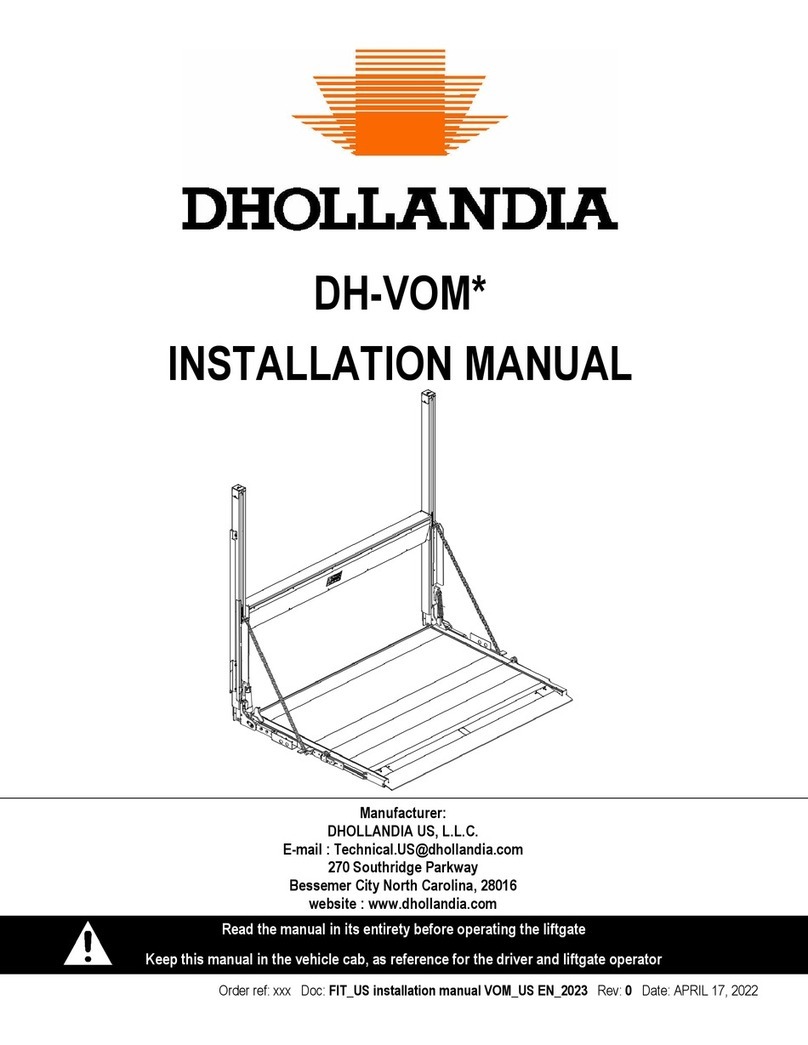
Dhollandia
Dhollandia DH-VOM Series installation manual
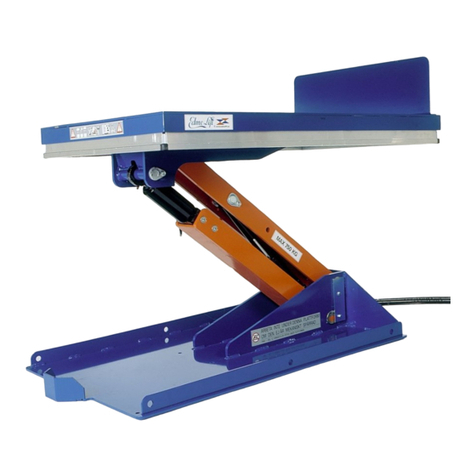
edmolift
edmolift ALT 750 product manual

Titan Lifts
Titan Lifts HD2P-10000AC-D Installation, operation & maintenance manual
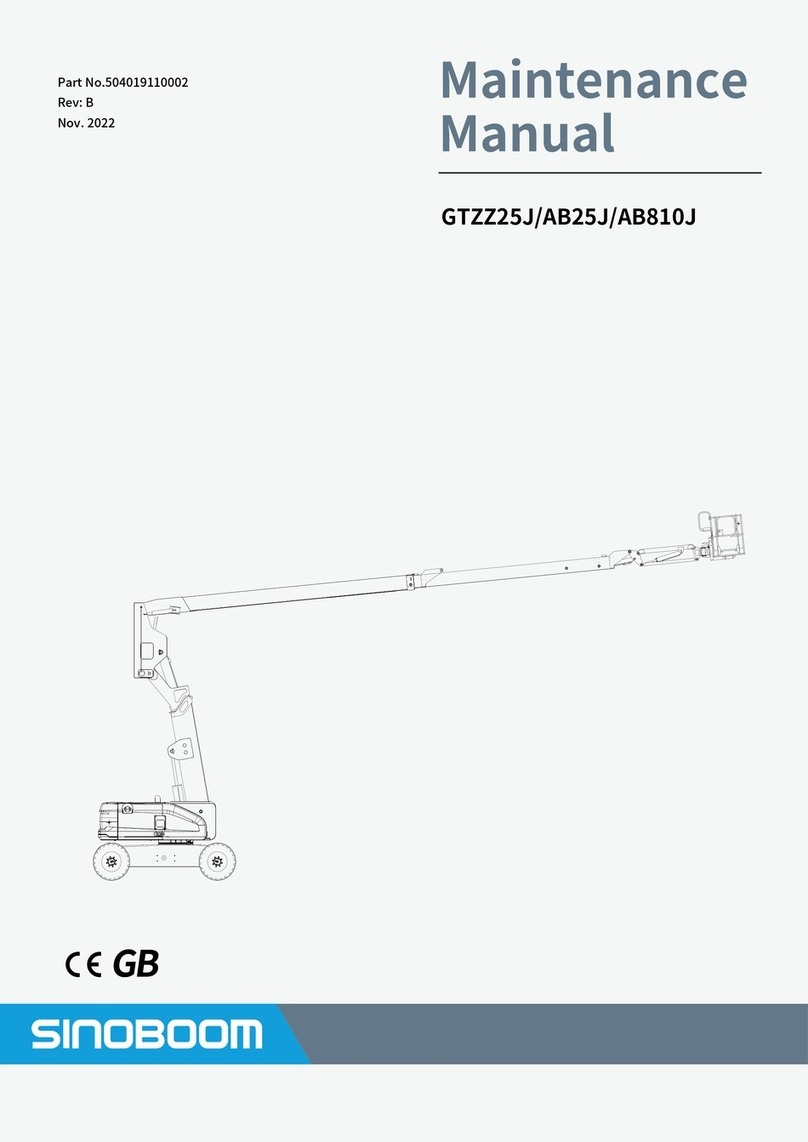
Sinoboom
Sinoboom GTZZ25J Maintenance manual
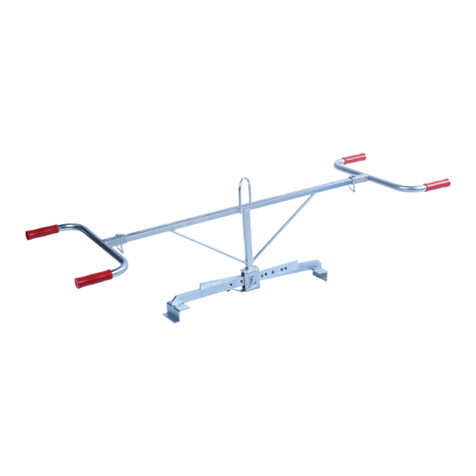
probst
probst VZ-I operating instructions
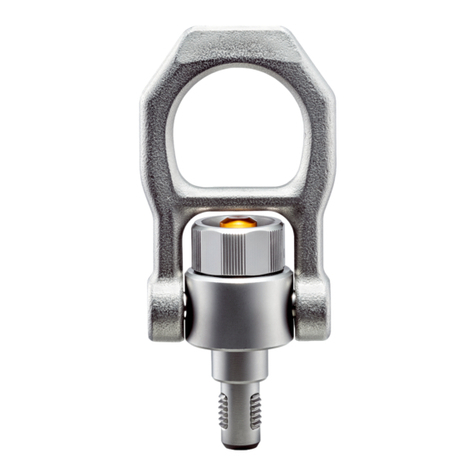
HALDER
HALDER EH 2B353 Short instruction manual






